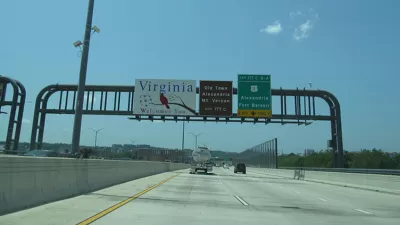New express lanes on I-66 inside the Capital Beltway on I-66 will be significant for two reasons. First, no lanes will be added. HOV lanes will be converted to HOT lanes. Second, revenue will go to options to get drivers out of cars, such as transit
"For the first time, the Virginia Department of Transportation plans to set up [high occupancy toll] HOT lanes without first adding lane capacity," writes Robert Thomson for the Dr. Gridlock column.
The state government’s plan is to convert today’s rush-hour High Occupancy Vehicle (HOV or carpool) lanes to high-occupancy toll lanes in the middle of 2017. The construction work — basically a matter of setting up tolling gantries and their support system — is simple compared to the politics behind it.
Thomson explored those politics in two earlier pieces posted here: one on the I-66 HOT lane project last June and a January piece that dealt with the principles behind HOT lanes. More recently, a Vox piece posted in November delved into false claims made by opponents of these lanes.
Note: While The Washington Post refers to toll/carpool lanes using the generic high-occupancy toll, or HOT, abbreviation, the Virginia Department of Transportation (VDOT) uses "express lanes," e.g., 95 and 495 Express Lanes, as do most other public transportation agencies and state departments of transportation (DOTs).
"The Commonwealth Transportation Board, Virginia’s policy-making panel on transportation projects, voted (December 9) to approve the creation of HOT lanes on Interstate 66 inside the Capital Beltway," writes Thompson.
The board also accepted a deal with the Northern Virginia Transportation Commission that gives the commission control over distributing toll revenue for programs, such as carpooling and commuter buses, that are designed to help commuters leave their cars behind and avoid the tolls before getting on I-66.
“Before spending a minimum of $100 million to widen the road, it is fiscally responsible for the commonwealth to exhaust all common-sense options that will get traffic to move more efficiently through increased bus use, transit options and better managing the space we have by encouraging carpooling," states Transportation Secretary Aubrey L. Layne, Jr. in a VDOT press release.
Improvements can start quickly in a cost efficient manner. This project finances itself, with every cent raised from toll revenues going back into the corridor.
"For solo divers who choose to pay the toll during the four peak hours eastbound in the morning and westbound in the afternoon, the Virginia Department of Transportation estimates the average toll at $6 each way," adds Thompson.
If you questioned the ability of states to toll existing interstates, "there is general permission for state DOTs to convert HOV lanes on Interstates to HOT lanes, and to add new tolled lanes to Interstates," wrote Bob Poole, Director of Transportation Policy for Reason Foundation in an email.
In addition to tolling individual lanes on interstates, there are three states, North Carolina, Virginia, and Missouri that are authorized to toll all lanes of specified interstates per the 1998 Interstate System Reconstruction And Rehabilitation Pilot Program, a provision of TEA-21. However, they are in danger of losing that ability per the FAST Act, according to a recent New York Times article:
Under the new transportation bill, these states will have one year to move ahead with plans to add tolls or lose their slots to other states ready to add tolls to their highways. The new states then would have three years to complete projects or be removed from the pilot.
Hat tip to AASHTO Journal.
FULL STORY: Dr. Gridlock: Virginia panel okays I-66 HOT lanes inside Beltway

Maui's Vacation Rental Debate Turns Ugly
Verbal attacks, misinformation campaigns and fistfights plague a high-stakes debate to convert thousands of vacation rentals into long-term housing.

Planetizen Federal Action Tracker
A weekly monitor of how Trump’s orders and actions are impacting planners and planning in America.

In Urban Planning, AI Prompting Could be the New Design Thinking
Creativity has long been key to great urban design. What if we see AI as our new creative partner?

King County Supportive Housing Program Offers Hope for Unhoused Residents
The county is taking a ‘Housing First’ approach that prioritizes getting people into housing, then offering wraparound supportive services.

Researchers Use AI to Get Clearer Picture of US Housing
Analysts are using artificial intelligence to supercharge their research by allowing them to comb through data faster. Though these AI tools can be error prone, they save time and housing researchers are optimistic about the future.

Making Shared Micromobility More Inclusive
Cities and shared mobility system operators can do more to include people with disabilities in planning and operations, per a new report.
Urban Design for Planners 1: Software Tools
This six-course series explores essential urban design concepts using open source software and equips planners with the tools they need to participate fully in the urban design process.
Planning for Universal Design
Learn the tools for implementing Universal Design in planning regulations.
planning NEXT
Appalachian Highlands Housing Partners
Mpact (founded as Rail~Volution)
City of Camden Redevelopment Agency
City of Astoria
City of Portland
City of Laramie




























